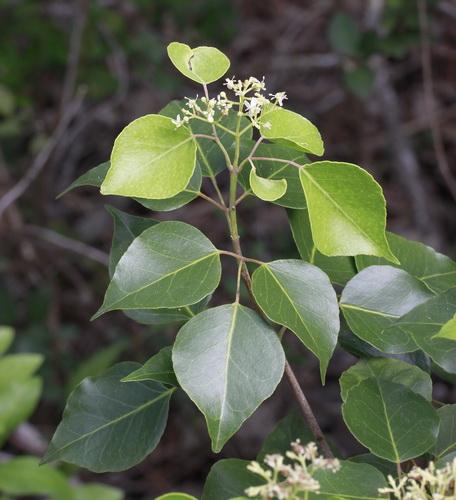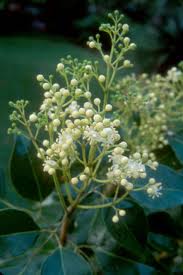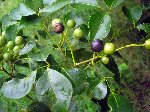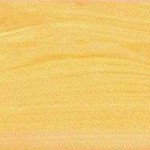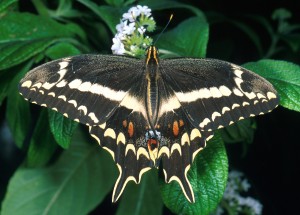One reason to write about the Torchwood is very few people know about it these days yet it was once an esteemed wood and produces an edible, citrusy fruit.
Torchwood, also called Sea Amyris and Sea Torchwood, is a large shrub or small tree found in the coastal hammocks of Florida and the Keys. It is also native to the Bahamas, the Virgin Islands, the West Indies and Central America. Torchwood doesn’t reach up the west coast of Florida but on the east side manages to populate up to about St. Augustine but only on the coast. Makes one wonder why? Northward gulf stream perhaps? Botanically it is Amyris elemifera (AM-irr-iss, el-em-IF-er ah.) Remember, in dead Latin “ifera” and its various forms means “bearing” or “producing.” Bulbifera bulb bearing, papyifera, paper bearing, cerifera, wax bearing et cetera. In in this case the Torchwood is packed with resin, elemifera means resin bearing. It’s in the Rutaceae family which includes Citrus also known for its resinous qualities.
Torchwood’s very oil-ladened wood has been used or fuel and the branches make excellent torches, hence the name. In fact, it burns so brightly it was used for night fishing to capture species attracted to light. Torchwood has also been used medicinally. In Florida Torchwood is highly valued for different reasons these day. It is the food source for the rare and endangered Schaus Swallowtail Butterfly. And besides humans, many birds eat the small, fleshy aromatic fruit.
The mature wood is hard, close-grained, and light tan to orange colored. It’s used to make torches, posts and furniture, and is resistant to dry termite rot. In one study Torchwood fence posts were still in good shape after 13 years in the tropical ground.
Amyris is from the Greek word αμυρων (amiron, AH-mee-ron), which means “intensely scented.” It was also the name of a Greek in Sybaris (now Italy) who was surnamed “The Wise.” Amyris was sent by his fellow citizens to consult the famous oracle at Delphi. His reputation for wisdom gave rise to the Greek proverb Άμυρις μαίνεται, “the wise man is mad.”
Green Deane’s “Itemize” Plant Profile: Torchwood
IDENTIFICATION: Amyris elemifera: Torchwood is a medium sized tree that can grow as tall as 40′ to 50′ but most often is never larger than a bushy shrub. It has a slender trunk, 10″ to 15″ in diameter. The leaves are opposite, evergreen, and compound. They are 2″ to 4½” long and composed of three leaflets. Each leaflet is 1″ to 2½” long and ovate to ovate to lanceolate in shape. The leaflets have a long, tapered end, a rounded or wedge-shaped base, and smooth or finely toothed margins. That means the leaves are pointed and drooping. The widest area of the leaves is usually in the middle. They may be medium-sized to somewhat narrow. The leathery leaflets are lustrous bright green above and dull green with glandular dots below. The bark is thin, smooth, and brownish gray. On large trunks the bark has shallow furrows roughened by small patches of exfoliating bark. Twigs, leaves, and fruits have slight citrus odor when crushed.
TIME OF YEAR: Flowering and fruiting irregularly during the year but favors March to October.
ENVIRONMENT: Torchwood grows on sandy, rocky soils near the ocean and high, rich hammocks farther inland. Does well on moist, well-drained sandy or limestone soils, with humus top layer. Salt tolerant.
METHOD OF PREPARATION: White flowers lead to purple to black, round, cherry-like drupe covered by a bluish, waxy bloom. The flesh is thin, fragrant and edible. One seed, pale brown. Don’t eat the seed.
HERB BLURB
From a report 5 May 1966: “An alcoholic extract of this plant was made and an acidified aqueous solution was purified with ether and chloroform. This aqueous extract was fractionated on an ion exchange column and the spectra of the eluates were investigated. From the spectra it appears that pteridine and purine structures are indicated for the alkaloids.”

